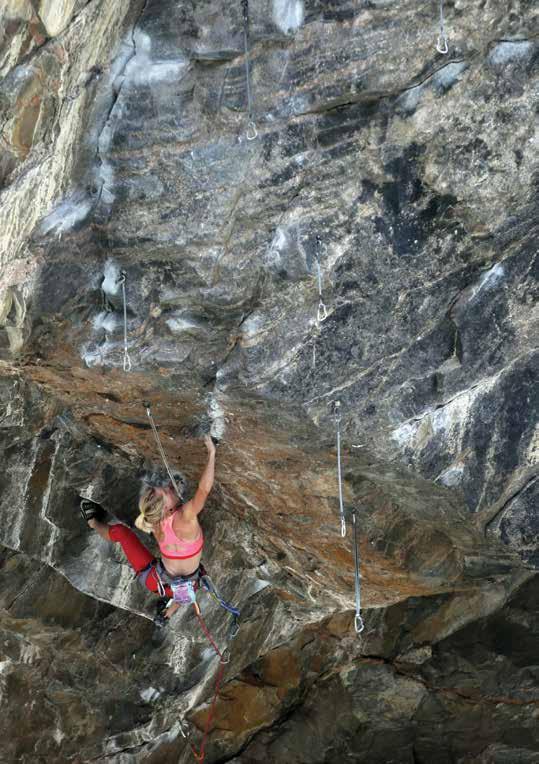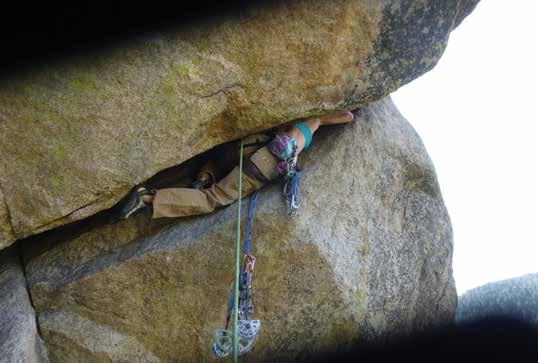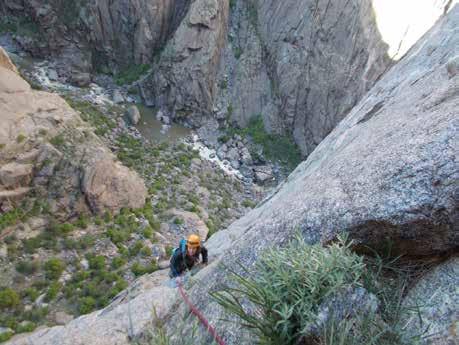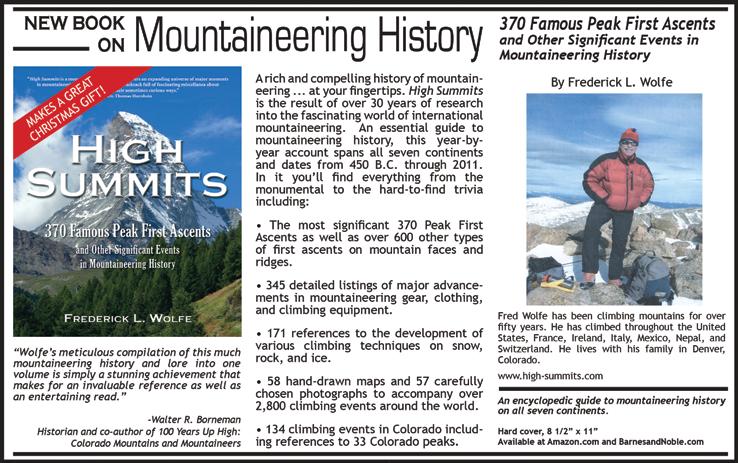
9 minute read
Climbing in Colorado’S CanyonS
Front Range Crags to Backcountry Escapes
By Helen Sinclair
The author on Sonic Youth 5.13a in Clear Creek. Photo by Jen Friedberg
he steep walls, rushing river, and winding road all play a part in the experience of climbing in Colorado’s many canyons. Whether you are after a quick morning run up an easy route before work, an adventurous all-day multi-pitch climb, or a camping trip with some climbing tied into it, Colorado’s canyons offer varied and unique options that will satisfy any type of climber from the first timer to the pro. Even simply driving up a canyon road is an experience. We have all done it: slowed down and peered over the steering wheel to check out the climber up on a steep wall above, giving ourselves a fright after taking our eyes off the winding road, or hearing the angry horn from the car behind us.
All of life’s stresses can be forgotten once up high with just the next move to focus on. Kayakers can often be spotted from the wall, seemingly fearlessly tackling the spring rapids. Central to this climbing experience is the inability to hear your climbing partner clearly because of the overpowering road and river sounds. This pushes climbing teams to perfect their communication skills, something vital for any climber, but especially important to those hoping to move from this training ground to greater alpine challenges.
Part of what makes a great place for a climber to live is the ability to get out climbing after work. Living in the Front Range is the choice or dream of many climbers because of this. There are three main canyons to climb within an hour’s drive of numerous city centers in the region: Denver, Golden, and Boulder, to name a few. It was these three canyons, Clear Creek, Eldorado, and Boulder Canyon, that immediately came to mind when I was asked to write about climbing in Colorado’s canyons. Of course, there are others too—including a few secret spots—but these three probably see the most traffic both on the roads that run through them and in the numbers of climbers testing their abilities on the walls.
Clear Creek Canyon runs alongside Highway 6 and is often used as an alternative route to Interstate 70. It has a lot of trucks coming and going from the quarries in the canyon. Because of this, the road is wildly busy, and I find that the scariest part of my climbing day is walking alongside and crossing the road to get from the car to the crag. But once up on the rock, the road is forgotten. The traffic sounds melt away into a gentle rumble and merge with the roar of the river. The climbs in Clear Creek are mostly well-bolted sport routes that range in grade from total beginner, at crags such as High Wire area, to a good selection of 5.10s and 5.11s. But for me, the reason why I would choose this canyon over any other is because it has such a large range of high-quality routes between the 5.12 and 5.13 grade range. This canyon offers fantastic red-point project potential. Even if you are just a casual local climber looking to have a quick outdoor workout, choosing a climb a few grades harder than what you would normally climb and visiting it regularly until the moves are pieced together is a perfect activity in Clear Creek, where the approaches are short and parking is easy.
Eldorado, or “Eldo”, is possibly the most widely known of the three canyons, with a huge range of old school trad routes put up by many a famous climber. (Be warned, these routes come with old school grades, too.) There are also a few bolted lines and the occasional boulder tucked away between the longer traditional routes. I have repeated many routes in this canyon because the creative, interesting climbing is so fun I just want to do the climbs over
The author inside Oomph Slot, an off-width test piece on The Dome in Boulder Canyon. Photo by Said Parirokh

Gearing up for the Tyrolean traverse across Boulder Creek to climb North Face Center 5.7 on Cob Rock. Photo by Helen Sinclair

and over. My top picks for this place are The Yellow Spur—six pitches of 5.10 that can be very bold in places, especially if you are not used to runouts—and The Naked Edge, also six pitches, a test piece at 5.11a that has what I like to call “a few airy moments.” Go climb it, and you will see what I mean! Both are very popular and for good reason. So plan your day and enjoy any company you may have onroute.
In contrast, just one major canyon over is Boulder Canyon. There are both trad lines and bolted lines to climb, as well as boulder problems, some of which are the hardest in Colorado. Many groups use the various crags such as The Sport Park for teaching climbing, and most of the pro sport climbers seek harder routes in other places. There are quality routes throughout the canyon. Country Club Crack, a test piece and a rite of passage into the 5.11 grade, is one example. And Cob Rock, a 5.8 trad, makes for a fantastic introduction to multi-pitching. Tyrolean traverses are positioned up and down this canyon and add to the canyon’s climbing experience.
Because of their proximity to the city and because there are so many climbers in the area, all three of the canyons discussed so far are often busy, particularly if you are climbing routes 5.11 and below on a weekend. Be prepared to hang out at the crag with others, make friends, and have fun with one another. Some crags, like the Wall of the 90’s in Clear Creek, can resemble a climbing gym with ropes and gear scattered about at the base and someone hanging from a rope on every route. That is exactly what makes these canyons so great. And even though the place is usually full of people, you can still get many routes done in a short space of time. Crowds can be avoided even on weekends by choosing slightly harder routes, walking a little farther, or getting out on the rock before 11 AM.
While on the subject of areas that resemble climbing gyms, I must mention Rifle. Before I went to Rifle, I had heard so many negative comments about the place, I was expecting to find a mud hole with a mob of arrogant 5.14 climbers. I was impressed and surprised to find neither of these. Instead, I drove into a pretty, lush, green canyon with a perfectly crystal clear stream running through it. The crags are busy, and lining up for one of the many polished but high quality single-pitch sport routes is common. There is a lot of discussion involving knee bars, heel-toe cams, drop knees, and very few places where the word “jug” is used frequently. Yes, there are many pro climbers who visit this area’s large concentration of 5.14s; however, I have only ever received positive encouragement from them and, when I have asked for it, received exceptionally detailed beta, including play-by play moves, who put it up, who did it last week, a lengthy explanation of what its grade is, when it was downgraded and then upgraded again because a hold fell off, etc. After a trip to this location, I leave feeling worked and motivated to train harder so I can return just that little bit stronger.
If you are one who believes climbing should be just you, your partner, and the rock—you probably aren’t living in the populated metro Front Range—there are many canyons that offer seclusion. While still popular, the Black Canyon of the Gunnison is farther from the crowds and has many routes. It also has a wide range of grades to choose from. Without a doubt, “The Black” promises adventure.


Left: The author on Sonic Youth 5.13a in Clear Creek. Photo by Jen Friedberg . Right: Holly Barrass climbing in Black Canyon. Photo by Monilisa Aquino
It’s unique in that you park at the top and walk, scramble, or slide down to the base of the routes and then climb out. This gives a feeling of commitment you don’t get in other canyons. Combined with its long trad multi-pitch, the possibility of loose rock, and its isolated feel, the Black Canyon is always a long day even if not planned as such.
The general consensus is that the Black Canyon of the Gunnison is scary. I asked a few climbers about their experiences in the Black, and one friend said, “It tests your mind, your body, your spirit. You can get the worst poison ivy of your life, the worst chapped lips you’ve ever had, cramps from dehydration, and the next day you can feel like someone beat you with a cast-iron skillet. But it’s some of the best, boldest climbing I’ve done in North America. I love it!” Another said, “Intimidating from the moment you rap in and commit to coming back out. Great rock, bad rock, and long routes make this some of the most memorable climbing I’ve done!”
Another away-from-it-all canyon is Penitente Canyon located in the San Luis Valley, in south-central Colorado. It’s primarily a sport climbing destination with a few trad lines and beautiful camping. It is also rumored that the potential for development as a bouldering location is limitless. The majority of routes are 5.10 and above, but easier grades can be found at some crags, and groups do use this place, too. The bolted protection is safe and well maintained, making it a great place to hang-dog till you get the moves wired.
Not far from Grand Junction is Colorado’s version of Indian Creek—Escalante Canyon. Few crowds and adherence to Leave No Trace by the developers makes this spot perfect for anyone looking for that quiet, isolated crack climbing experience. Often there are no bolted anchors, leaving you with the feeling that you’re the first ever to climb the route!
I am also sure that there are many more lesser-known canyons hiding all over the state. A tiny roadless canyon in the vicinity of Coal Creek Canyon is one of those secret crags I know of—above a raging creek with a dubious approach and over a breathtaking Tyrolean. Skunk Canyon is another that offers a secluded little spot between the Flatirons away from crowds. This one also has no road and only a tiny creek, so it gives the impression of climbing well away from it all when really you are just a hop, skip, and a jump off one of the Flatirions’s busiest trails. The routes range from a must-do, four-starred, 8-pitch 5.2 trad route named Angels Way to a burly 5.12d sport roof called The Guardian. Both ends of the spectrum in this canyon are worth checking out.
Whether it’s a polished and popular crag or a committing, isolated, multi-pitch climb, climbing in canyons is a quintessential part of climbing in Colorado. Look out for rattlesnakes, cross the rivers carefully, place good gear, be bold, try your hardest, and climb like there is no place else you would rather be. △
Helen Sinclair is a ski patroller, climber, and climbing coach living in Boulder, Colorado.







